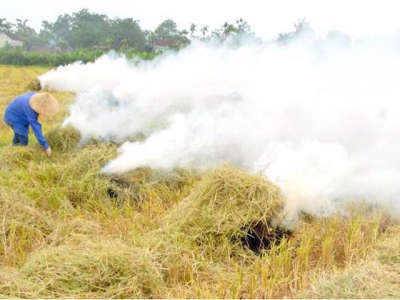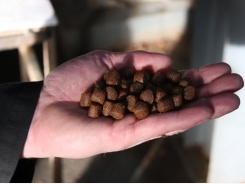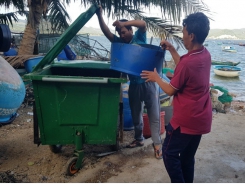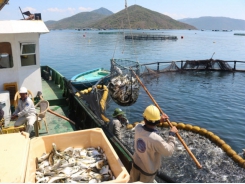Agricultural by-products going to waste

The annual volume of agricultural by-products generated in Vietnam is around 157 million tons, most of which simply goes to waste. It is therefore necessary to use technology to effectively handle and process such by-products.
Most of the agricultural by-products are being burned, or discharged into the environment, both wasteful and polluting... That's the story discussed at the webinar "The current status of agricultural and forestry by-products, fisheries in the South and propose solutions" organized by the Ministry of Agriculture and Rural Development on September 10, 2021.
MUST SEE THE SUBJECTS AS RENEWAL RESOURCES
Mr. Tran Thanh Nam, Deputy Minister of Agriculture and Rural Development, said that our country has a developed tropical agriculture with large and diverse agricultural output, meeting the consumption needs of over 97 million people. and exported over 41 million USD to over 180 countries and territories.
In the process of production, preservation, preliminary processing and processing of such agricultural products, the proportion of by-products from the forestry, cultivation, husbandry and aquaculture industries is very large.
From the perspective of a circular agricultural economy associated with green growth, this agricultural by-product must be considered a renewable resource, not a waste, but an important input source of the process. another cycle to prolong the value-added chain in agriculture.
Mr. Tong Xuan Chinh, Deputy Director of the Department of Livestock Production, said that the total theoretical volume of by-products of the whole country in 2020 is over 156.8 million tons, including: 88.9 million tons of by-products after harvesting from trees. cultivation, from the processing of agricultural products of the crop industry (accounting for 56.7%); 61.4 million tons of livestock and poultry manure from the livestock industry (accounting for 39.1%); 5.5 million tons from the forestry sector (accounting for 3.5%) and about 1 million tons from the fisheries sector (10.6%).
Kien Giang is the province with the largest total agricultural by-products in the Mekong Delta with 5.7 million tons per year, followed by An Giang with 5.2 million tons.
In particular, in the South region alone, agricultural by-products are mainly from the cultivation and livestock industry, with more than 13.9 million tons in 2020 in the Southeast and 39.4 million tons in the Mekong Delta.
According to Mr. Chinh, the post-harvest crop by-products have a large volume of 42.8 million tons of rice straw, 10 million tons of corn stalks, 3.6 million tons of vegetables and fruits, and 3.1 million tons of cassava stalks. tons, dug-out fake fruit (cashew) 3.1 million tons and others 6.1 million tons.
By-products from the processing of agricultural products of the horticulture industry are 8.6 million tons of rice husks, 3.5 million tons of bagasse, 1.4 million tons of corn cobs, 1.3 million tons of cassava husks and others. is 2 million tons.
Although the amount of agricultural by-products is very large, the collection rate of crop by-products is only 52.2% of the total volume of 88.9 million tons; livestock production has a collection rate of 75.1% of the total volume of 61.4 million tons; Fishery has the highest collection rate with 90% of the total by-products of 1 million tons and forestry has a collection rate of 50.2% of the total volume of 5.5 million tons.
In which, the rate of using rice straw is only 56.3% for the purposes of making raw fodder for grazing cattle, as filler for livestock, as biological padding for livestock, as straw mushroom, Root cover for plants, lining of fruits...
“In particular, a significant amount of straw was burned in the fields in some places in the North and Central region, causing air pollution, obstructing traffic, affecting human health and being a prohibited act. according to the provisions of the environmental law", Mr. Chinh warned.
EVERYTHING CAN TURN TO MONEY
Mr. Chinh said that the current and future trends, the market for straw collection, packaging, transportation and trading will grow more and more.
In the winter-spring crop of 2021 in Dong Thap province, the selling price of straw is about 55,000 - 75,000 VND per 1,000m2 of field, equivalent to 400 VND/kg, the price of straw next to the inter-commune road is 15,000 VND/bundle, equivalent to 1,250 VND/ kg.
If transported far, the selling price of straw at the establishment used for cattle raising, mushroom making, gardening... is about 25,000 VND/bundle, equivalent to 2,083 VND/kg. Therefore, rice farmers, in addition to harvesting rice, after harvesting, can also collect an average of 550,000 VND/ha of rice straw if sold to collectors.
For livestock waste, 48.5% is currently using traditional composting (compost), of which 11% generates biogas; 31.8% sold worm farming or discarded…
According to Mr. Le Van Thiet, Deputy Director of the Plant Protection Department, the rate of factories using organic raw materials to produce organic fertilizers is still quite low.
Specifically, using 43% of livestock waste; 33.2% plant processing waste; 17.9% crop by-products; 16.2% animal and aquatic product processing waste; organic household waste 8.1% and seaweed, seaweed only 5.1%.
Dr. Mai Thanh Phung, Vice Chairman of the Vietnam Association of Farms and Agricultural Enterprises, said that currently in the process of producing, harvesting, and processing fruit in the South, the amount of mango seeds, banana peels and durian skins. … a lot, but a lot of places are going to waste. While we can reuse it to make organic fertilizer for plants right in the orchards of mango, dragon fruit, watermelon...
Mr. Phung suggested promoting communication to help farmers and businesses get involved, turn agricultural by-products into organic fertilizer, and reduce dependence on imported sources. If done well, it is possible to increase the production of organic fertilizers of current enterprises from 4 million tons/year to 10 million tons/year.
"Farmers themselves can produce organic fertilizers with an output of 30 tons/year. The goal is that by 2030, we can make up to 50 tons of organic fertilizer, aiming to reduce the source of fertilizers. toxic inorganic fertilizers for agricultural products and the environment".
Dr. Mai Thanh Phung, Vice President of Vietnam Association of Farms and Agricultural Enterprises
Prof. Dr. Vo Tong Xuan said that the collection and reuse of agricultural by-products not only helps reduce greenhouse gas emissions but also gives farmers the opportunity to get rich.
“Currently, Vietnam's seafood by-product processing industry only reaches about 275 million USD, but, if the by-products of nearly 1 million tons of the seafood industry are fully exploited by high technology, processed into functional foods, Cosmetics can earn 4-5 billion USD", noted Dr. Vo Tong Xuan.
At the workshop, experts said that in order to increase the efficiency of using agricultural by-products, it is necessary to innovate mechanisms and policies through reducing corporate income tax, import tax on equipment and technology to encourage the use of agricultural by-products. encourage enterprises to invest in the field of collection, packaging, transportation, preservation and processing of crop and livestock by-products in order to extend the value-added chain in agriculture.
On the other hand, it is necessary to research, develop, transfer and apply high and new technologies to effectively apply in the field of processing and processing agricultural by-products.
Related news
Tools

Phối trộn thức ăn chăn nuôi

Pha dung dịch thủy canh

Định mức cho tôm ăn

Phối trộn phân bón NPK

Xác định tỷ lệ tôm sống

Chuyển đổi đơn vị phân bón

Xác định công suất sục khí

Chuyển đổi đơn vị tôm

Tính diện tích nhà kính

Tính thể tích ao




 Carbon farming opportunities beckon farmers
Carbon farming opportunities beckon farmers  Protecting marine environment decides sustainability for aquaculture
Protecting marine environment decides sustainability for aquaculture